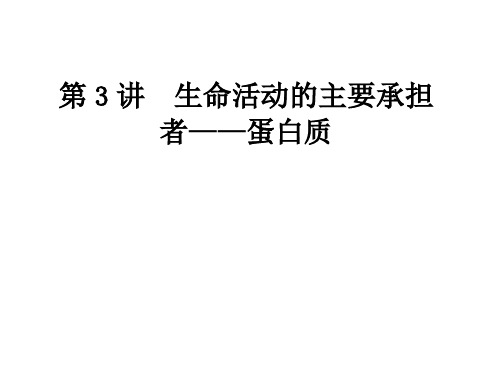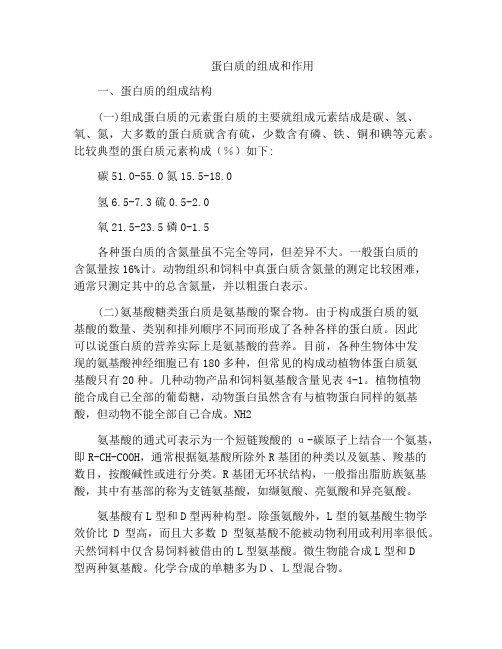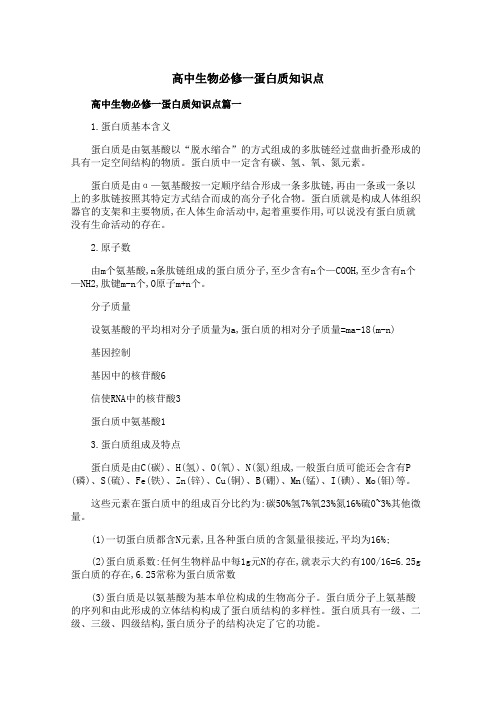蛋白质构成
蛋白质的基本组成单位是

蛋白质的基本组成单位是
氨基酸是组成蛋白质的基本单位。
蛋白质是以氨基酸为基本单位构成
的生物高分子。
蛋白质分子上氨基酸的序列和由此形成的立体结构构成了
蛋白质结构的多样性。
蛋白质具有一级、二级、三级、四级结构,蛋白质
分子的结构决定了它的功能。
氨基酸分子的羧基,脱去一分子水而连接起来,这种结合方式叫做脱
水缩合。
缩合反应在羧基和氨基之间形成的连接两个氨基酸分子的键叫做
肽键。
一个氨基酸分子的氨基和蛋白质用约20种氨基酸作原料,在细胞
质中的核糖体上,将氨基酸分子互相连接成肽链。
扩展资料
蛋白质结构:一级结构:氨基酸残基在蛋白质肽链中的排列顺序称为
蛋白质的一级结构,每种蛋白质都有唯一而确切的氨基酸序列;二级结构:蛋白质分子中肽链并非直链状,而是按一定的规律卷曲或折叠形成特定的
空间结构,这是蛋白质的二级结构;
三级结构:在二级结构的基础上,肽链还按照一定的空间结构进一步
形成更复杂的三级结构;四级结构:具有三级结构的多肽链按一定空间排
列方式结合在一起形成的聚集体结构称为蛋白质的四级结构。
如血红蛋白
由4个具有三级结构的多肽链构成。
营养学基础 蛋白质

四、.膳食蛋白质的来源与营养价值
1.氮平衡:蛋白质分解代谢与合成代谢处于动态平衡状态。 如果蛋白质供应不足,处于负氮平衡状态,供应充足 则处于正氮状态。 2.缺乏蛋白质的后果: (1)成人:表现为疲倦、无力、体重降低、血浆清蛋白 下降、肌肉萎缩、贫血等症状,严重时出现水肿。 (2)儿童:影响儿童生长。如果能量基本满足要求,但 蛋白质严重不足,易患儿童营养性疾病,主要表现为 腹部、腿部水肿,身体虚弱、生长滞缓和表情淡漠, 头发变色、变脆和易脱落,易感染其它疾病。另一种 能量和蛋白质均不足,表现为“消瘦”。
三、食物中蛋白质营养价值的评价
3.蛋白质的利用率
(1)定义:食物蛋白质被消化吸收后在体内被利用的 程度 (2)蛋白质的生物价(BV) 指食物蛋白质经消化吸收后被机体利用吸收的一项指标 公式: BV =被利用的氮/被吸收的氮×100% BV越高,营养价值越高,其高低决定于必需氨基酸的 含量、种类及其比值。常见食品蛋白质的最高生物价 是鸡蛋黄(96),较低的是豌豆(48)。
7.限制氨基酸: 食物中含量相对较低的必需氨基酸使食物蛋白 质合成为机体蛋白的过程受到限制,限制了此 种蛋白质的营养价值,称为限制性氨基酸。从 理论上说,评定一种蛋白质的营养价值时,应 当根据9种必需氨基酸的构成比例来全面综合 评定。实际工作中只采用赖氨酸、蛋氨酸或色 氨酸的含量来比较就可以了,因为它们是主要 的限制性氨基酸。
1.构成身体组织:人体各组织、器官无一不含蛋白 质。身体的生长发育可视为蛋白质的不断积累过程, 因而蛋白质的对儿童的生长发育特别重要。人体内各 种组织的蛋白质始终在不断更新,只有摄入足够的蛋 白质才能维持组织的更新。身体受伤后也需要蛋白质 作为修复材料。 2.调节生理功能:蛋白质在体内是构成具有重要生 理活性物质的成分,如酶、激素等。 3.供给能量:经脱氨基作用生成的α-酮酸可以直接 或间接经三羧酸循环氧化分解,同时释放能量。供给 能量是蛋白质的次要功能。
高中生物蛋白质

生命活动的主要承担 者——蛋白质
一.组成蛋白质的基本单位——氨基酸
1. 组成蛋白质的基本元素: C、H、O、N,有的还含 Fe、 S 。 2. 基本单位—— 氨基酸 。 (1)种类:①R 基不同, 20 种。
结构通式:
。
结构特点:一个中心碳原子上连接一个 氨基 、一个 羧基 、一 个 H 和一个 R基团 。 不同氨基酸的区别在于 R基团 的不同。
3.有一种毒蘑菇,是环状8肽,如果氨基酸的 平均分子质量是128,求毒蘑菇的相对分子 质量? 4.某蛋白质相对分子量是11935,脱去的水分 子量是1908,若氨基酸的平均分子量是127, 求肽链的条数?
5.免疫球蛋白ⅠgG 的结构如图所示,其中—S—S— 表示连接两条相邻肽链的二硫键。若该ⅠgG 由 m 个氨基酸构成,则该ⅠgG 有肽键数及形成该蛋白 质时相对分子质量减少了 ( D )
A.m 个
(m-4)×18 (m-4)×18 (m-4)×18-6 (m-4)×18+6
B.(m+1)个 C.(m-1)个 D.(m-4)个
6. 某蛋白质的结构示意图如图所示, 其中—S—S—表 示连接两条相邻肽链的二硫键。 若该蛋白质由 m 个 氨基酸构成,则该蛋白质分子在形成时生成的水分 子数和减少的相对分子质量分别为( )
2.下列关于蛋白质结构和功能的叙述中,错误的是 ( D ) A.不同种类的蛋白质不仅氨基酸的数量和排列顺 序不同,而且各自具有独特的空间结构 B.蛋白质之所以具有多种生理功能,是因为它具 有多种多样的结构 C.蛋白质的多样性也是长期进化的结果 D.开水煮沸鸡蛋清,不仅破坏了其中蛋白质的空 间结构,同时也破坏了氨基酸之间的肽键
A.A 和 B 是染色体的主要成分 B.过程 1、2、4 都有水的产生 C.密码子存在于 B 和 C D.过程 3、4 进行的场所和所利用的酶不同
蛋白质的组成和作用

蛋白质的组成和作用一、蛋白质的组成结构(一)组成蛋白质的元素蛋白质的主要就组成元素结成是碳、氢、氧、氮,大多数的蛋白质就含有硫,少数含有磷、铁、铜和碘等元素。
比较典型的蛋白质元素构成(%)如下:碳51.0-55.0氮15.5-18.0氢6.5-7.3硫0.5-2.0氧21.5-23.5磷0-1.5各种蛋白质的含氮量虽不完全等同,但差异不大。
一般蛋白质的含氮量按16%计。
动物组织和饲料中真蛋白质含氮量的测定比较困难,通常只测定其中的总含氮量,并以粗蛋白表示。
(二)氨基酸糖类蛋白质是氨基酸的聚合物。
由于构成蛋白质的氨基酸的数量、类别和排列顺序不同而形成了各种各样的蛋白质。
因此可以说蛋白质的营养实际上是氨基酸的营养。
目前,各种生物体中发现的氨基酸神经细胞已有180多种,但常见的构成动植物体蛋白质氨基酸只有20种。
几种动物产品和饲料氨基酸含量见表4-1。
植物植物能合成自己全部的葡萄糖,动物蛋白虽然含有与植物蛋白同样的氨基酸,但动物不能全部自己合成。
NH2氨基酸的通式可表示为一个短链羧酸的α-碳原子上结合一个氨基,即R-CH-COOH,通常根据氨基酸所除外R基团的种类以及氨基、羧基的数目,按酸碱性或进行分类。
R基团无环状结构,一般指出脂肪族氨基酸,其中有基部的称为支链氨基酸,如缬氨酸、亮氨酸和异亮氨酸。
氨基酸有L型和D型两种构型。
除蛋氨酸外,L型的氨基酸生物学效价比D型高,而且大多数D型氨基酸不能被动物利用或利用率很低。
天然饲料中仅含易饲料被借由的L型氨基酸。
微生物能合成L型和D型两种氨基酸。
化学合成的单糖多为D、L型混合物。
蛋白质的围成和作用二、蛋白质的性质和分类(一)蛋白质的性质蛋白质凭借游离的氨基和而具有两性特征,在肉叶荠易生成沉淀。
不同的蛋白质肉叶荠不同,该特性常用作蛋白质的蛋白质分离提纯。
生成的沉淀按其有机结构沉淀和化学性质,通过pH的细微变化可复溶。
蛋白质的两性特征或使其成为很好缓冲剂,并且由于其分子量大和离解度低,在水溶液维持蛋白质溶液形成的渗透压中也起着重要作用。
蛋白质ppt全

氮 13%~19%
硫 0—4%
其他 微 量
一、蛋白质的组成和分类
2、蛋白质的分类
(1)依据蛋白质中必需氨基酸的种类和数量
分类
可以分为完全蛋白质、半完全蛋白质和不完全蛋白质
●完全蛋白质 所含的必需氨基酸种类齐全,数量充
足,彼此比例适当。这一类蛋白质不但可以维持人体
健康,还可以促进生长发育。如乳中的酪蛋白及乳白
因体内蛋白质仍要分解,故易出现氮的负平衡;若摄食蛋
白质的量太大,不仅机体利用不了,甚至反而加重消化器
官及肾脏等的负担。不过,蛋白质的需要量与能量不同,
满足蛋白质的需要和大量摄食蛋白质引起有害作用的量相
差甚大。
第三节 必需氨基酸
一、必需氨基酸与非必需氨基酸
二、必需氨基酸的需要量及需要量模式
三、限制氨基酸
氮平衡对机体的作用
实际上,N平衡不是绝对的。
一天内,进食时N平衡为正;晚上不进食时则N平衡为
负;超过24小时这种波动才比较平稳。
机体在一定限度内对N平衡具有调节作用,健康成人
每日进食蛋白质有所增减时,其体内蛋白质的分解速度及
随尿排出的氮量也随之增减。如进食高蛋白膳食时尿中排
出的氮量增加,反之则减少。但若长期进食低蛋白质膳食,
一般说,蛋白质约占人体全部质量的18%,最
重要的还是其与生命现象有关。蛋白质和核酸
是生命存在的主要形式。
二、建造新组织和修补更新组织
食物蛋白质最重要的作用是供给人体合成蛋白质所需要
的氨基酸。由于碳水化合物和脂肪中只含有碳、氢和氧,
不含氮。因此,蛋白质是人体中惟一的氮的来源。这是碳
水化合物和脂肪不能代替的作用。
葡萄糖有氧氧化所获得的能量为无氧酵解的18倍。这种由
营养学基础蛋白质

氨基酸聚合形成肽链,一条或几条肽链聚合 在一起就构成了蛋白质,构成天然蛋白质的 6 氨基酸共20种。
7
二肽 三肽 四肽 二肽→ +肽称寡肽(oligopeptide)
多肽(Polypeptide)
8
9
一 级 结
构
10
11
二 级 结 构
12
血红蛋白
13
为了对蛋白质结构叙述的方便,人为地将蛋白质的结构分为
3、维持和调节体内的酸碱平衡及血浆渗透压 当长期缺乏蛋白质时血浆蛋白质含量下 降,血液内的水分便渗入周围组织,造成营 养性水肿。
29
二、蛋白质的生理功能
4、参与神经冲动的传导及遗传信息的传递 5-羟色胺等氨基酸代谢产物是重要的神 经递质,参与神经冲动的传导。
30
二、蛋白质的生理功能
5、供给能量 蛋白质含碳、氢、氧元素,机体需要时, 可代谢分解,释放热能。
本组成单位。
蛋白质是一切生命的物质基础,没有蛋白质
就没有生命。
3
第一节
蛋白质的结构和组成
二、蛋白质的组成
C:50-55% H:6.7-7.3% O :19-24% N :13-19%(大多数蛋白质含氮量为16%,折算系数为6.25)
蛋白质是人体氮的唯一来源,碳水化合物和脂肪不能代替
S:0-4% P、Fe、I、Mn、Zn等
(1)单纯蛋白:包括动、植物组织中的白蛋白、球蛋白和 植物中的谷蛋白、麦醇溶蛋白等。 ①硬蛋白:不溶于水,消化酶对其不易水解。硬蛋白包 括骨胶原、弹性硬蛋白、角蛋白,一般为身体的支持组织。 ②白蛋白:易溶于水,加热凝结。白蛋白含在鸡蛋、牛 奶和人体血液中。 ③球蛋白:在水中溶解度低,加热凝固。球蛋白广泛存 在于自然界中,如血清球蛋白、肌肉球蛋白、植物球蛋白。 ④谷蛋白:不溶于水,溶于稀酸和稀碱,消化酶可水解。 谷蛋白在谷粒中含量丰富,如小麦谷蛋白。
蛋白质的元素组成

一、蛋白质的元素组成蛋白质是一类含氮有机化合物,除含有碳、氢、氧外,还有氮和少量的硫。
某些蛋白质还含有其他一些元素,主要是磷、铁、碘、锌和铜等。
各种蛋白质的含氮量很接近,平均为16%。
按照蛋白质的组成,可以分为1.简单蛋白(simple protein) :又称为单纯蛋白质;这类蛋白质只含由α-氨基酸组成的肽链,不含其它成分。
(1)清蛋白和球蛋白:albumin and globulin广泛存在于动物组织中。
清蛋白易溶于水,球蛋白微溶于水,易溶于稀酸中。
(2)谷蛋白(glutelin)和醇溶谷蛋白(prolamin):植物蛋白,不溶于水,易溶于稀酸、稀碱中,后者可溶于70-80%乙醇中。
(3)精蛋白和组蛋白:碱性蛋白质,存在与细胞核中。
(4)硬蛋白:存在于各种软骨、腱、毛、发、丝等组织中,分为角蛋白、胶原蛋白、弹性蛋白和丝蛋白。
2.结合蛋白(conjugated protein):由简单蛋白与其它非蛋白成分结合而成(1)色蛋白:由简单蛋白与色素物质结合而成。
如血红蛋白、叶绿蛋白和细胞色素等。
(2)糖蛋白:由简单蛋白与糖类物质组成。
如细胞膜中的糖蛋白等。
(3)脂蛋白:由简单蛋白与脂类结合而成。
如血清α-,β-脂蛋白等。
(4)核蛋白:由简单蛋白与核酸结合而成。
如细胞核中的核糖核蛋白等。
(5)色蛋白:由简单蛋白与色素结合而成。
如血红素、过氧化氢酶、细胞色素c等。
(6)磷蛋白:由简单蛋白质和磷酸组成。
如胃蛋白酶、酪蛋白、角蛋白、弹性蛋白、丝心蛋白等。
依据蛋白质的营养价值分类:按照蛋白质含的必需氨基酸的种类、数量、比例可分为完全蛋白、半完全蛋白和不完全蛋白。
1.完全蛋白:必需氨基酸的种类齐全、数量充足、比例恰当。
2.半完全蛋白:必需氨基酸的种类齐全、但有的氨基酸数量不足、比例不恰当。
3.不完全蛋白:必需氨基酸的种类不全。
蛋白质的功能一、构成和修复组织;二、调节生理功能;三、供给机体热能。
氨基酸为L-α-氨基酸(L-α-amino acid),其结构通式如下:必需氨基酸的定义、种类氨基酸模式(amino acid pattern):某种蛋白质中各种必需氨基酸的构成比例。
构成蛋白质的元素

构成蛋白质的元素
1.蛋白质的组成元素有碳、氢、氧、氮等。
蛋白质是以氨基酸为基本单位构成的生物高分子。
2.蛋白质是由C(碳)、H(氢)、O(氧)、N(氨)组成,一般蛋白质可能还会含有P(磷)、S(确、Fe(铁)、Zn(锌)、Cu(铜)、B(硼)、Mn(锰)、I(碘)、Mo()等。
3.这些元素在蛋白质中的组成百分比约为:碳50%、氢7%、氧23%、氨16%、硫0~3%、其他微量。
4.一切蛋白质都含氨元素,且各种蛋白质的含氨量很接近,平均为16%;
5.蛋白质系数:任何生物样品中每1g元氨的存在,就表示大约有
100/16=6.25g蛋白质的存在,6.25常称为蛋白质常数。
6.一级结构:氨基酸残基在蛋白质肽链中的排列顺序称为蛋白质的一级结构,每种蛋白质都有唯一而确切的氨基酸序列。
7.二级结构:蛋白质分子中肽链并非直链状,而是按一定的规律卷曲(如α-螺旋结构)或折叠(如β-折叠结构)形成特定的空间结构,这是蛋白质的二级结构。
8.三级结构:在二级结构的基础上,肽链还按照一定的空间结构进一步形成更复杂的三级结构。
肌红蛋白,血红蛋白等正是通过这种结构使其表面的空穴恰好容纳一个血红素分子。
9.四级结构:具有三级结构的多肽链按一定空间排列方式结合在一起形成的聚集体结构称为蛋白质的四级结构。
如血红蛋白由4个具有三级结构的多肽链构成,其中两个是x链,另两个是β-链,其四级结构近似椭球形状。
组成蛋白质、核酸、糖类、脂肪、磷脂、固醇的元素

组成蛋白质、核酸、糖类、脂肪、磷脂、固醇的元素
蛋白质、核酸、糖类、脂肪、磷脂和固醇是生命体中的基本物质,它们都由不同的元素组成。
蛋白质中含有氢、氧、氮和碳,此外还包括硫、磷等元素。
这些元素是构成蛋白质的基本结构单元,是细胞和组织的基本组成部分。
核酸是构成遗传物质的基本单位,包括DNA和RNA。
它们由氢、氧、氮、碳和磷等元素构成,其中磷元素是构成核酸分子的特有元素。
糖类是生命体中的主要能量来源,也是构成细胞壁和组织结构的重要物质。
糖类主要由氢、氧和碳组成,不同的糖类含有不同的分子结构。
脂肪是细胞膜结构的重要组成部分,也是生命体中的重要能量来源。
它们由氢、氧和碳元素构成。
磷脂是构成细胞膜的重要物质,由氢、氧、碳和磷元素组成。
磷脂可以形成双层膜结构,保护细胞内部的物质。
固醇是一类重要的生物分子,包括胆固醇、雌激素、睾酮等。
它们由氢、氧和碳组成,有助于细胞膜的稳定和调节细胞功能。
- 1 -。
营养学基础知识2(蛋白质)

同一种食物在不同的实验条件下,所测得 的功效比值往往有差异。为了使实验结果 具有一致性和可比性,实验期间用标定酪 蛋白为参考蛋白设对照组,无论酪蛋白质 组的功效比值为多少,均应换算为2.5,即 被测蛋白质的功效比值可按下式计算:
PER=[实验组功效比值/对照组功效比 值]×2.5
如民间流传的腊八粥、素什锦等传统食 品配方即是植物蛋白质互补的实例;而 荤素混用,可使食品蛋白质的生物价提 高更明显。
七、蛋白质来源与供给量
1.来源 人类的蛋白质来源分为动物性和植物性两大类。
日常的食物又可分为全谷类、蔬菜水果类、肉 鱼蛋类、豆类、奶类等六大类,都含有蛋白质。 一般认为,蛋白质含量丰富,且品质良好的食 物有肉类、鱼类、蛋类、奶类、豆类、坚果类 等。大部分植物蛋白的品质要次于动物蛋白质, 但大豆蛋白除外。大豆蛋白中的必需氨基酸组 成与动物性蛋白质相近。
综合上述所有评定指标来看,蛋白质含量 越高,必需氨基酸种类越全,含量及比值 越接近人体蛋白质的必需氨基酸构成模式 的蛋白质质量越好。
3.氨基酸评分
氨基酸评分(AAS)亦称蛋白质化学评分(CS) 是一种评定食物蛋白质营养价值的方法。这种方 法既适用于单一食物蛋白质评定,亦适用于混合 食物蛋白质评定。计算公式如下:
I、F、U分别代表食物氮、粪氮和尿氮。
Fm、Um分别为粪代谢氮及尿内源氮。
②蛋白质的净利用率(NPU)=生物价× 消化率=[氮储留量÷氮食入量]×100
氮储留量= I-(F-Fm)-(U-Um) 氮食入量=I I、F、U分别代表食物氮、粪氮和尿氮。 Fm、Um分别为粪代谢氮及尿内源氮。
(2)蛋白质功效比值
蛋白质功效比值(PER)是测定蛋白质利 用率的另一简便方法。用出生后21~28天刚 断奶的雄性大白鼠(体重50~60g),以含 被测蛋白质10%的合成饲料饲养28天。同 时,经过标定的酪蛋白为参考蛋白质,在 同样条件下,作为对照组进行测定。试验 期内动物平均每摄取1g蛋白质所增加的体 重克数,称为PER。
蛋白质的结构和功能

蛋白质的结构和功能蛋白质是生物体内最重要的分子之一。
它们在细胞结构、传递信息、代谢调节等方面都起着重要作用。
蛋白质由一系列氨基酸残基链构成,它们的空间结构和序列决定了它们的功能。
本文将介绍蛋白质的结构和功能。
一、蛋白质的结构蛋白质结构可以从四个层次来描述:1. 一级结构:蛋白质的一级结构是由多肽链上的氨基酸排列顺序决定的。
一级结构由肽键连接氨基酸,形成肽链,其三维结构确定蛋白质的稳定性和活性。
2. 二级结构:二级结构指一级结构中短距离的主链的空间排列方式。
主要由α-螺旋和β-折叠两种排列方式组成。
3. 三级结构:三级结构是蛋白质的立体结构,由氨基酸排列和相互作用所形成的空间结构。
其主要形式有:α-螺旋外的环折叠、β-折叠内的环折叠、未定型区、多肽链拱形折叠等。
4. 四级结构:四级结构又称为超分子结构,是由多个蛋白质分子或其他小分子构成的复合物。
此外,还有底物识别结构等。
二、蛋白质的功能蛋白质的功能多种多样,下面介绍几种分类:1. 结构蛋白:结构蛋白的主要作用是维持细胞和组织结构,保持生物体物理结构的稳定性。
同时,还有储存、传递信息等功能。
2. 酶:酶在生物催化过程中扮演着重要角色。
大多数化学反应需要在标准条件下进行,而酶可以在生物体内提供适宜的催化条件。
生物体中几乎所有的催化都是由酶完成的。
3. 抗体:抗体是一种由B细胞产生的蛋白质,具有识别和抵抗抗原的能力。
它们通过特定的结构来识别抗原,达到抵抗和清除抗原的作用。
4. 载体:载体是一种分子,能够绑定其他小分子或离子,并将其运输到细胞内或细胞外。
例子包括血红蛋白、肌红蛋白等。
三、结构与功能关系蛋白质结构决定了它的功能,改变结构通常也会影响到它的功能。
类似地,蛋白质的功能也可以通过调节结构来实现。
其方法包括改变氨基酸序列、改变外界条件以及调节与其他分子之间的相互作用等。
总之,蛋白质的结构和功能非常复杂,并且是相互关联的。
因此,对蛋白质进行深入的研究有助于更好地了解生命起源和生命体系的机制,也对制药、医学等领域的发展有重要意义。
蛋白质主要由哪些元素组成

二、蛋白质的性质
3.变性
*由蛋白质变性引起的蛋白质凝结是不 可逆的,其使蛋白质的性质变化;
*蛋白质变性凝结后丧失可溶性,还失 去生理活性。
1.为什么医院用高温蒸煮,照射紫外线, 喷洒苯酚溶液,在伤口处涂抹酒精的方 法来杀菌?
2.为什么生物实验室用甲醛溶液保存标 本?
3.为什么在农业上用波尔多液(由硫酸 铜,生石灰和水制成)来消灭害虫?
1、重要的营养物质——生命的物质基础 2、工业上的应用 ①纺织工业——蚕丝、羊毛 ②皮革工业——动物毛皮经鞣制后作原料 ③感光材料工业——动物胶(白明胶)是
制感光材料的片基 ④塑料工业——制酪素塑料
酶-生物活性(生物催化作用)的蛋白质。 特点: 1.条件温和,不需加热.(体温和中性条件) 2.高度的专一性. 3.高效性.比普通催化剂高107-1013倍
二、蛋白质的性质
4.颜色反应 蛋白质可以和许多试剂发生特殊的
颜色反应.如某些蛋白质(分子里含有苯 环)跟浓硝酸作用产生黄色.
*注意:颜色反应可用于鉴别蛋白质. *此外,蛋白质灼烧产生烧焦羽5.水解反应:蛋白质在酸、碱或酶的催化 下,最终水解成氨基酸。
三、蛋白质的用途—课本P202
二、蛋白质的性质
12..蛋盐白析质:演的示两性-NH2的碱性、-COOH的酸性 溶a.液鸡-蛋-观清察蛋现白象溶-液有+饱沉和淀(析NH出4)2SO4或Na2SO4 b.在所得沉淀中加蒸馏水--观察现象-沉 淀消失
蛋白质在浓无机盐溶液中因胶体凝聚而析 出,叫做盐析。盐析是可逆的,表示如下:
采用多次盐析法,可以分离和提纯蛋白质
练习
●下式表示某蛋白质分子结构的一部分, 用箭头和(A)、(B)、(C)、(D) 标出分子中不同的化学键。当蛋白质水 解时,断裂( )
蛋白质基础知识

7、营养学评价
人体对蛋白质的需要实际上是对氨基酸的需要。
机体在蛋白质的代谢过程中,对每种必 需氨基酸的需要和利用都处在一定的范 围之内。某一种氨基酸过多或过少都会 影响另一些氨基酸的利用。所以,为了 满足蛋白质合成的要求,各种必需氨基 酸之间应有一个适宜的比例。这种必需 氢基酸之间相互搭配的比例关系称为必 需氨基酸需要量模式。
3、分类
3.5 根据来源可分为: 动物中蛋白质:如猪肉、鱼肉、鸡肉、乳 植物中蛋白质:如大豆、谷物 微生物中蛋白质:酵母
3、分类
3.6 营养学上根据食物蛋白质所含氨基酸的种类和数 量将食物蛋白质分三类: 完全蛋白质:氨基酸种类齐全,数量充足,可以维 持人体健康,还可以促进生长发育。如乳中的酪蛋 白、乳白蛋白、蛋类中卵黄磷蛋白;肉类中的白蛋 白和肌蛋白;大豆的大豆蛋白;小麦的麦谷蛋白和 玉米中的谷蛋白等。 半完全蛋白质:氨基酸种类齐全,但其中某些氨基 酸的数量不能满足人体的需要。可以维持生命,但 不能促进生长发育。如小麦中的麦胶蛋白。 不完全蛋白质:不能提供人体所需的全部必需氨基 酸,不能促进生长发育,也不能维持生命。如玉米
8、常见的蛋白质
角蛋白 存在于毛发、指甲、羽毛、角等中。 在氨基酸构成中,胱氨酸含量比较高。 角蛋白含有大量二硫键, 而且蛋白折叠很紧密, 这些结构特征使角蛋白很难被一般的蛋白酶 降解。其次, 角蛋白中一些必需氨基酸,如蛋 氨酸(Met) 、赖氨酸(Lys) 、组氨酸(His) 和色 氨酸(Trp)含量偏低, 这进一步降低了羽毛的 营养价值。
食物氮 反映蛋白质在消化道内被分解的程度和消化后的氨 基酸和肽被吸收的程度。
7、营养学评价
影响蛋白质消化率的因素很多。通常, 动物性蛋白质的消化率比植物性的高。 这是因为植物蛋白质被纤维素包围不易 被消化酶作用。经过加工烹调后、包裹 植物蛋白质的纤维素可被去除、破坏或 软化;可以提高其蛋白质的消化率。例 如食用整粒大豆时,其蛋白质消化率仅 约60%,若将其加工成豆腐,可提高到
构成蛋白质的化学元素

构成蛋白质的化学元素1.引言1.1 概述蛋白质是生命体内极其重要的一类有机化合物,它们在维持生命活动中扮演着至关重要的角色。
构成蛋白质的化学元素是研究蛋白质的基础,了解这些元素的特性和功能对于深入理解蛋白质的结构和功能至关重要。
蛋白质主要由碳(Carbon)、氢(Hydrogen)、氧(Oxygen)、氮(Nitrogen)和少量的硫(Sulfur)组成。
这些元素共同组成了蛋白质分子中的各种功能基团和侧链结构,决定了蛋白质的化学性质和生物活性。
碳是蛋白质分子的基本框架,它以共价键的形式连接着其他元素和功能基团。
氢则主要存在于蛋白质分子中的脂肪酸基团和侧链上。
氧元素组成了蛋白质分子中的羟基(-OH)和酮基(C=O),在蛋白质的酸碱特性和水合性质中起着重要作用。
氮元素是蛋白质分子中最为丰富的元素,它以胺基(-NH2)的形式存在于氨基酸单元中,构成了蛋白质分子中的多肽链。
氮元素在蛋白质的氨基酸序列和螺旋结构的形成中起着重要作用。
此外,少量的硫元素存在于蛋白质的某些氨基酸中,如蛋氨酸(Cysteine)和半胱氨酸(Methionine)。
硫元素通过形成二硫键(S-S)对蛋白质分子的结构和稳定性起着至关重要的作用。
总而言之,构成蛋白质的化学元素包括碳、氢、氧、氮和少量的硫。
这些元素的特性和相互作用决定了蛋白质的结构和功能,对于揭示生命活动的奥秘具有重要意义。
深入研究蛋白质的化学元素可以进一步拓展我们对于生命的理解,为药物研发、疾病治疗等领域提供新的突破。
1.2 文章结构文章结构部分的内容可以包括以下信息:文章的结构是为了使读者能够清楚地了解和理解本文的主题和内容。
本文将按照以下几个主要部分进行组织和展示:第一部分是引言,用于引入文章的主题和目的。
引言包括概述、文章结构和目的三个小节。
概述部分将简要介绍蛋白质的重要性和研究价值,以及蛋白质在生物体中的普遍存在性。
该部分将概括性地说明蛋白质构成的问题,并引出后文所要讨论的主题。
营养学基础——蛋白质

一、氨基酸命名
按酸碱性分类: 1、酸性氨基酸 天冬氨酸、谷氨酸 2、碱性氨基酸 精、赖、组 3、中性氨基酸
二、氨基酸的分类(人体内Байду номын сангаас 1、必需氨基酸
必需氨基酸(essential amino acid) 人体不能合成或合 成速度不能满足机体需要,必须从食物中直接获得的氨 基酸 。包括:缬氨酸、异亮氨酸、亮氨酸、苯丙氨酸、
实验组 PER 校正 PER= × 2.5 对照组 PER
(2)生物价或生物学价值(biological value ,BV)
指食物蛋白质被消化吸收后在体内储留的氮量与
吸收的氮量的比值。表示蛋白质经过消化吸收后,
进入机体可以储留和利用的程度
氮储留量 蛋白质生物学价值 = × 100 氮吸收量 氮吸收量 = 摄入氮 —(粪氮—粪代谢氮) 氮储留量 = 氮吸收量 —(尿氮—尿内源氮)
氨酸转变而成,如果膳食中能够直接提供两种氨
基酸,则人体对蛋氨酸和苯丙氨酸的需要减少
30%和50% 。
3、非必需氨基酸(nonessential amino acid):
人体自身可以合成以满足机体需要的氨基酸。
包括丙氨酸、精氨酸、天门冬氨酸、羟脯氨酸、
脯氨酸、谷氨酸、谷氨酰胺、甘氨酸、丝氨酸。
三、氨基酸模式及限制氨基酸(食物中)
(四)按蛋白质的营养价值分类
1.完全蛋白质:氨基酸种类齐全、数量充足、比例适当。 2.半完全蛋白质:氨基酸种类齐全、数量不足、比例不当 小麦中的麦交蛋白等。 3.不完全蛋白质:氨基酸种类不齐、数量不足、比例不当。 如胶原蛋白等 玉米、土豆(色氨酸含量极低)
三、蛋白质的功能
1、人体组织的构成成分
人体的任何组织和器官都以蛋白质作为重要的组
高中生物必修一蛋白质知识点

高中生物必修一蛋白质知识点高中生物必修一蛋白质知识点篇一1.蛋白质基本含义蛋白质是由氨基酸以“脱水缩合”的方式组成的多肽链经过盘曲折叠形成的具有一定空间结构的物质。
蛋白质中一定含有碳、氢、氧、氮元素。
蛋白质是由α—氨基酸按一定顺序结合形成一条多肽链,再由一条或一条以上的多肽链按照其特定方式结合而成的高分子化合物。
蛋白质就是构成人体组织器官的支架和主要物质,在人体生命活动中,起着重要作用,可以说没有蛋白质就没有生命活动的存在。
2.原子数由m个氨基酸,n条肽链组成的蛋白质分子,至少含有n个—COOH,至少含有n个—NH2,肽键m-n个,O原子m+n个。
分子质量设氨基酸的平均相对分子质量为a,蛋白质的相对分子质量=ma-18(m-n)基因控制基因中的核苷酸6信使RNA中的核苷酸3蛋白质中氨基酸13.蛋白质组成及特点蛋白质是由C(碳)、H(氢)、O(氧)、N(氮)组成,一般蛋白质可能还会含有P (磷)、S(硫)、Fe(铁)、Zn(锌)、Cu(铜)、B(硼)、Mn(锰)、I(碘)、Mo(钼)等。
这些元素在蛋白质中的组成百分比约为:碳50%氢7%氧23%氮16%硫0~3%其他微量。
(1)一切蛋白质都含N元素,且各种蛋白质的含氮量很接近,平均为16%;(2)蛋白质系数:任何生物样品中每1g元N的存在,就表示大约有100/16=6.25g 蛋白质的存在,6.25常称为蛋白质常数(3)蛋白质是以氨基酸为基本单位构成的生物高分子。
蛋白质分子上氨基酸的序列和由此形成的立体结构构成了蛋白质结构的多样性。
蛋白质具有一级、二级、三级、四级结构,蛋白质分子的结构决定了它的功能。
4.蛋白质性质蛋白质是由α-氨基酸通过肽键构成的高分子化合物,在蛋白质分子中存在着氨基和羧基,因此跟氨基酸相似,蛋白质也是两性物质。
(1)水解反应蛋白质在酸、碱或酶的作用下发生水解反应,经过多肽,最后得到多种α-氨基酸。
蛋白质水解时,应找准结构中键的“断裂点”,水解时肽键部分或全部断裂。
构成蛋白质空间结构的基本单位

构成蛋白质空间结构的基本单位蛋白质,这个听起来高大上的词,实际上和我们生活息息相关。
你知道吗?它们可不只是存在于那些看似奢华的牛排或者豆腐里,甚至在我们身体的每一个细胞里,都是默默奉献的“小工蜂”。
今天,就让我们来聊聊构成这些蛋白质的基本单位,听起来是不是很神秘?别急,咱们一步步揭开这个迷雾。
1. 蛋白质的基本构成1.1 氨基酸的角色首先,得提到氨基酸。
嘿,别小看这几个字,它们可是蛋白质的“砖头”。
没错,蛋白质就像一座华丽的建筑,而氨基酸就是那一块一块的砖。
我们一共认识二十种不同的氨基酸,它们就像性格各异的朋友,有的爱开玩笑,有的比较内向。
它们通过肽键连接在一起,形成长长的链子,最后卷成复杂的三维结构,哎呀,真是个神奇的过程。
1.2 蛋白质的多样性更神奇的是,不同的氨基酸组合会形成不同的蛋白质,像是做菜一样,调料不一样,味道也会大相径庭。
有些蛋白质负责支撑和保护细胞,有些则在体内运输养分,就像快递小哥一样忙忙碌碌。
这种多样性可真让人惊叹,简直是生物界的一场大联欢。
2. 蛋白质的空间结构2.1 二级结构与折叠说到蛋白质的空间结构,就得提到二级结构。
蛋白质链子在折叠的过程中,会形成一些非常有趣的形状,比如α螺旋和β折叠。
想象一下,螺旋就像是旋转的滑梯,而折叠则像是折纸艺术,虽然过程复杂,但最后的结果却是美轮美奂。
就像我们常说的“众人拾柴火焰高”,这些结构的形成可不是一蹴而就的,而是经过长时间的努力和调整。
2.2 三级结构的魅力然后,我们再聊聊三级结构。
这时候,蛋白质就变得更为复杂,仿佛是个小精灵,千变万化。
它们的折叠和缠绕形成了一个独特的三维结构。
这个结构决定了蛋白质的功能,比如酶就是一种特殊的蛋白质,能够加速化学反应,简直是生物界的小超人!你要是能理解这些,绝对能在聚会中引起一番轰动,大家都会觉得你真是个知识渊博的“蛋白质专家”!3. 蛋白质的功能与应用3.1 生物功能说了这么多,咱们再看看蛋白质到底有啥用。
- 1、下载文档前请自行甄别文档内容的完整性,平台不提供额外的编辑、内容补充、找答案等附加服务。
- 2、"仅部分预览"的文档,不可在线预览部分如存在完整性等问题,可反馈申请退款(可完整预览的文档不适用该条件!)。
- 3、如文档侵犯您的权益,请联系客服反馈,我们会尽快为您处理(人工客服工作时间:9:00-18:30)。
几种食物和人体蛋白质氨基酸模式
氨基酸 异亮氨酸 亮氨酸 赖氨酸 蛋氨酸+半胱氨酸 苯丙氨酸+酪氨酸 苏氨酸 缬氨酸 色氨酸
人体 4.0 7.0 5.5 3.5 6.0 4.0 5.0 1.0
Threonine(Thr) 谷氨酰胺
Tryptophan(Trp) 甘氨酸
Valine(Val)
脯氨酸
丝氨酸
英文
Alanine(Ala) Arginine(Arg) Aspartic acid(Asp) Asparagine(Asn) Glutamic acid(Glu) Glutamine(Gln) Glycine(Gly) Proline(Pro) Serine(Ser)
dipeptide
氨基酸
必需氨基酸
异亮氨酸 亮氨酸 赖氨酸 蛋氨酸 苯丙氨酸 苏氨酸 色氨酸 缬氨酸
组氨酸*
构成人体蛋白质的氨基酸
英文
氨基酸
非必需氨基酸
Isoleucine(Ile) 丙氨酸
Leucine(Leu)
精氨酸
Lysine(Lys)
天门冬氨酸
Methionine(Met) 天门冬酰胺
Phenylalanine(Phe) 谷氨酸
式” • 1883年,John Kjeldahl建立凯氏定氮法 • 1902年,E. Fischer测定了氨基酸的化学结构
• 蛋白质是一切生命的物质基础,没有蛋白质就 没有生命
• 正常人体内约有16%~ 19%是蛋白质(如 70kg的男性成人含蛋白质12kg),
• 蛋白质含碳(50%~55%),氢(6.7%~7.3 %),氧(19%~24%),氮(13%~19%) 及硫(0%~4%)。每天约有3%被更新。
• Of the 20 amino acids, eight have to be provided in the diet for adults and are identified as being 'essential'
• 必需氨基酸(essential amino acid,EAA):不能在 体内合成或合成速度不能满足机体的需要,必须由 食物中直接获得的氨基酸。
complementary action
蛋白质互补作用:为了提高植物性蛋白质的营养 价值,往往将两种或两种以上的食物混合食用,而 达到以多补少的目的,提高膳食蛋白质的营养价值, 不同食物间相互补充其必需氨基酸不足的作用,称 为蛋白质互补作用。
蛋白质互补作用
食物名称
玉米 小米 大豆 小麦 小米 大豆 牛肉(干)
更新
分解 合成
修复
二、 Amino acid 氨基酸
• Nearly an infinite number of proteins could be synthesized from the 20 natural amino acids. 氨基酸是蛋白质的基本构成单位,构成人体蛋 白质的氨基酸有20种
大米 2.5 5.1 2.3 2.4 5.8 2.3 3.4 1.0
根据《食物成分表》(王光亚主编,人民卫生出版社,1991年)计算。大豆、全鸡蛋(红皮) 来自上海;鸡蛋白来自河北;牛奶产自甘肃;猪瘦弱、牛肉(里脊)、小麦标准粉来自北京; 大米为浙江早籼标二米。
Reference protein is standard protein that could measure the quality of the other proteins.
• what we need in relatively large amounts are macronutrients (carbohydrats, fats, proteins)需要量较大的称为常量营养素(碳 水化合物、脂肪、蛋白质);
• What we need in relatively small amounts are micronutrients(mineral elements and vitamins),需要量较小的称为微量营养素(矿
• The amino acids are linked in chains through peptide bonds. If a few amino acids-are coined together by peptide bonds the compound is called a "peptide.
• Good nutrition implies that we are obtaining from our food all of the essential nutrients in the amounts needed to keep our bodies functioning, and to maintain, optimum health.
– 半胱氨酸(蛋氨酸)、酪氨酸(苯丙氨酸)
• 人体蛋白质的氨基酸构成一致否? • 各种食物蛋白质的氨基酸构成一致否? • 意义? • 表示形式?
Amino acid pattern is composition of essential amino acid in food
氨基酸模式是蛋白质中各种必需氨基酸的 构成比例。
– 包括缬氨酸、亮氨酸、异亮氨酸、苏氨酸、蛋氨 酸、苯丙氨酸、色氨酸、赖氨酸
– 组氨酸为婴儿必需氨基酸
其他氨基酸
• 非必需氨基酸(nonessential amino acid)
– 丙氨酸、精氨酸、谷氨酸、谷氨酰胺、 甘氨 酸、丝氨酸、脯氨酸、天门冬氨酸、天门冬 酰胺
• 条件必需氨基酸(conditionally essential amino acid)
“Eating the right foods in the right amounts.”
• 营养良好这一术语是指我们处在从食物中获取 为保持机体正常活动和维持最佳健康状况所需 的全部必需营养素。
营养良好的最简明的说法是:“适量食用恰当 的食物”。
• Nutrients : The ingredients that give us nourishment in Food are called nutrients.
• 构成蛋白质的氨基酸之间通过肽键连结
•蛋白质被分解的产物是肽(peptide)和氨基酸
多肽(polypeptide) (含11个以上氨基酸)
二肽(dipeptide) (2个氨基酸)
蛋白质 分解
三肽(tripeptide) (3个氨基酸)
寡肽(oligopeptide) (含4~ 10个氨基酸)
物质和维生素)。
Protein 蛋白质
Contents of this class本节讲述内容
• History of protein 对蛋白质的认识历史
• Essential Amino Acid** 氨基酸和必需氨基酸
• Protein’s Function* 蛋白质的功能
• Digestion, Absorption and Metabolism 消化、吸收和代谢
• Nutrition might be defined as the processes whereby we obtain the essential nutrients and use them to make many other substances our bodies need. 营养可定义为一种人们赖以获得必需营养素, 并利用这些营养素来制造人体所需其他物质的 过程。
Histidine(His)
条件必需氨基酸
半胱氨酸 酪氨酸
Cysteine(Cys) Tyrosine(Tyr)
*组氨酸为婴儿必需氨基酸,成人需要量可能较少。 摘自Modern Nutrition in Health and Disease ,第9版,第14页,1999年。
Essential Amino Acid 必需氨基酸
Contents of this class本节讲述内容
• Evaluation the Nutrition Value of Food
Protein** 食物蛋白质营养学评价 • Dietary protein deficiency* 蛋白质营养不良 • Assessment of nutritional status 机体营养状况评价 • Protein Allowance and Food Source* 蛋白质供给量和来源
一、History of protein对蛋白质的认识历史
• 1728年,Beccaria发现“麦麸” 。 • 1811年,Gag-Lussac建立了C、H、O的定量分
析方法,发现动物组织中N含量很高 • 1837年,蛋白质的命名 • 1841年,Liegig以含氮量确定蛋白质营养价值 • 1878年,Engers指出“生命是蛋白质的存在形
HO
HN C C O H
H
酸性
基团
碱性 基团
H CH H
丙氨酸H CHBiblioteka 苯丙氨酸外周基团 不同
H
甘氨酸
O C OH H CH
天门冬氨酸
H HC H
O HNC C
HH
HC H O
O HH N C C HH
H HC H
O OHHNC C
HH
HC H O
NC C HH
OH
肽键
H2O
丙氨酸 + 苯丙氨酸
二肽
第二节 蛋白质
(Protein)
Nutrition 营养
• What we eat as well as how much we eat determine our nutrition status to an important extent. 人们的营养状况在很大程度上取决于人们吃什 么和吃多少。
